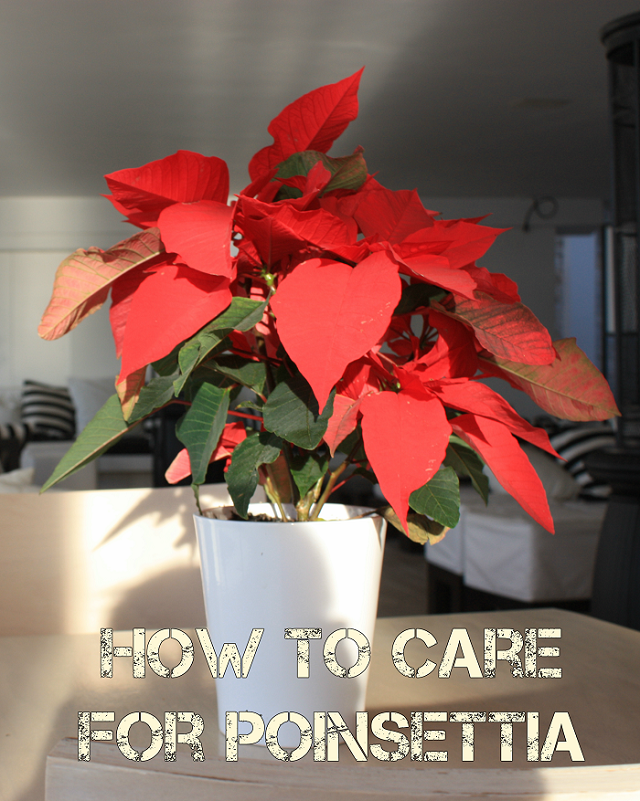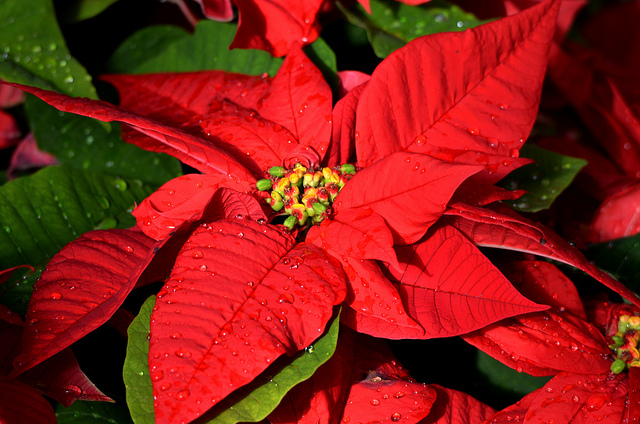Before poinsettia has become an advent and Christmas table decoration in our country, it enjoyed great popularity in its native region, Central America. Aztecs extracted a red dye from its leaves and used the plant as an antipyretic. Poinsettia was induced in Europe solely as a decorative plant about 100 years ago. The plant enjoys hot climates so much that it may reach even a 2-3 meter height.

Before buying this beautiful plant, consider whether you can ensure proper conditions for it in your home; otherwise, you will be able to enjoy it only for about a week. It is advisable to examine the plant even before buying it, as the dry, hot air in shopping centres will make them dry out fast. If you see any withered and yellowing leaves on a plant, don’t buy it, as the process of decay is often irreversible and the plant will die within a few days. If the plant is wrapped in cellpohane, open the wrapping and check the leaves, or ask a shop assistant to do that for you. Yellowing leaves can indicate the presence of pests as well. You should look for a plant that hasn’t reached its full blooming period yet, so you can enjoy its beauty for a longer time. You can easily spot the grains of pollen on its colorful leaves.
After having found a suitable plant, find a sunny but cool place for it in your home. If the plant is wrapped in cellophane, remove the wrapping at once, because the soil is prone to moulding, and the roots of the plant need plenty of oxygen. In the winter, cover the plant in tissue paper before walking out from the store, as major changes in temperature will damage the plant within a few minutes.
Nowadays, poinsettias are available in many sizes and colours: their flowers can be red, white and pink, and they can grow as tall as 1 meter.
Light and temperature preferences
Keep the plant in a sunny location, but away from glaring sunlight. Poinsettia doesn’t tolerate temperature changes and air drafts well. The best place for poinsettia is away from windows and doors, in a room that never gets colder than 16˚C and warmer than 20˚C. At higher temperatures, the plant will die fast. Dry air will damage it too, so make sure it is kept well away from radiators. The more light the plant receives, the longer the blooming period will be, and the prettier its red leaves will be.
Watering needs
If the air is too dry in your home, use a humidifier once a day to increase the humidity level. Keep its soil moist, but not sogging wet. Check the soil every second day, and add a little water if you find it too dry, and discard excess water from the saucer within a few minutes. Fertilize the plant weekly or every two weeks from the time new shoots appear.
The best watering method is to place the pot in a dish of tepid water once a week. If the soil is saturated with water, the plant doesn’t need to be watered for a week.

Further caring tips
Poinsettia is a rather hardy plant. It can show signs of needs for a long time without dying, and in regenetates easily. It can survive even a several days long summer holiday if it has been watered well before and it is not left in glaring sunlight. Its leaves will wither, but it will come back to life when watered. If taken care of properly, the plant will finish blooming by the end of February, and will lose its colorful leaves by April. If the plant is kept in a darker spot, losing flowers will happen somewhat earlier. At this time, cut off the shoots to a 15-20 cm length and remove the main shoot completely. Move the plant to a dark, cool place and water it only sparingly to give it a 1-2 month rest. After this period, transplant your poinsettia, preferably into a larger clay pot. The potting medium should be slighlty acidic, about 6.2 pH plant soil such as Florasca B, to imitate the original environment of the plant in Mexico.
Water the plant with moderation and feed it every three weeks during the spring, and then every two weeks during the summer with an all-purpose fertilizer. You may keep poinsettia outdoors during the summer, but make sure that it doesn’t sit in direct sunlight.
How to propagate poinsettia
Propagating poinsettia is very simple. In the spring or summer, cut off longer shoots and place them in water. Keep them in a warm and sunny place. They will root within 4-5 weeks; at this time, plant them in groups of twos or threes. It is enough to leave 3-4 shoots on the mother plant; if you leave more shoots, not all af them will turn red successfully. If needed, the mother plant may be cut back to 3-4 cm.
Propagatin by cutting is also possible: in this case, first allow the cut to dry and then plant it. However, propagation by cutting without keeping the shoots in water first is a lengthy and less successful process.
How to help poinsetia bloom a second time
Due to the light conditions of its native environment, poinsettia is adapted to short daylight hours. If you wish to help your plant bloom again, keep it in the dark for 12-14 hours per day until new flowers appear – this may take even two months. Even the smallest amount of light will prevent the plant from flowering, so it is important to choose a place where no light whatsoever can reach it. The simplest method is to cover the plant with a cardboard box between 7 pm and 8 am. If you miss covering it for a single night, it won’t bloom. Start covering your plant from the end of September or the beginning of October. If you do everything well, you will enjoy a blooming poinsettia at Christmas.
After blooming is over, which usually occurs in May, the plant will have a resting period. At this time, it loses its leaves. Some believe that their plant has died, but this is wrong. Sometimes the plant may keep its leaves; in this case, you should allow it to grow until August and cut its shoots off only at the end of the summer. Warn everybody in the family not to touch the plant, as even a small injury will cause it to bleed a poisonous liquid. If this happens, wipe off the liquid with a paper towel and then wash your hands thoroughly. Don’t keep poinsettia in a place where your pet can reach it!

The most common diseases of poinsettia
If the air is very dry in the room where poinsettia is kept, the plant may be attacked by spider mites or glasshouse whitefiles. If it is kept in an overheated room during the winter, its leaves will fall off. In some cases, grey mold or root rotting may kill the plant.
Warning
Poinsettia contains a poisonous liquid, which upon skin contact causes irritation or an allergic reaction. If ingested, it may cause stomachache and vomiting. As a very small amount of this liquid is sufficient to cause poisoning, make sure that your skin never comes in contact with it while you are grooming the plant. If, by any chance, the liquid gets onto your skin, wash it off immediately with plenty of water. If the liquid is ingested, drink a lot of fluids to help relieve the symptoms.
